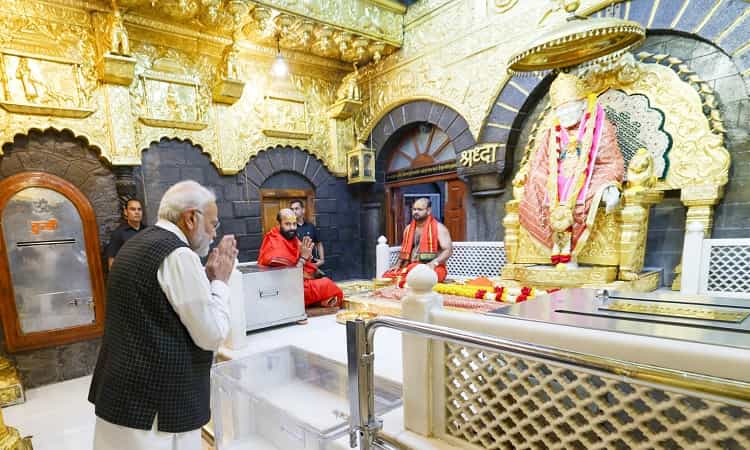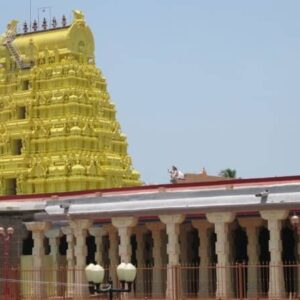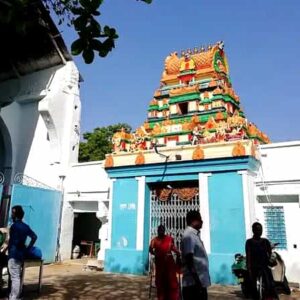Shirdi Saibaba Temple is a famous pilgrimage destination that attracts millions of devout followers of Saibaba, or Sai Ram as he is commonly called. Sai Baba, the fakir saint, has followers from both Hinduism and Islam. The humble town of Shirdi in the state of Maharashtra has become famous because of Saibaba, who resided in this town several years ago. In Shirdi, tales of Baba’s many miracles make their rounds, and the air and ambiance of the town resound with the name of Sai, cried aloud by pilgrims with deep devotion. This holy town today receives thousands of visitors each day, with pilgrims making a beeline to the Saibaba Temple to pay their obeisance at Baba’s lotus feet.
If you are planning to visit Shirdi soon, this blog on Shirdi temple timings will be helpful to you, providing all the details about the temple’s opening and closing hours, as well as the timings of the various aartis and rituals at the temple. Read on.

Shirdi Temple Timings for Everyday Pooja Rituals
The temple is thrown open at daybreak; i.e. 4 am and devotees are let in. Thousands of devotees continue to pay their visit to the temple until quite late at night. All through the day multiple poojas, rituals and aartis are conducted at the temple according to a specific time schedule and devotees are allowed to take part in those. Whether it’s the early hours of the dawn or the serene evening hours you as a devotee will definitely enjoy every moment you spend at the Shirdi Saibaba temple and will probably experience a deep connection with the Sai’s divine presence within the temple premises.
The timing for the various poojas and rituals at the Shirdi Sai Baba dimple are given below:
| Poojas at the temple | Timings |
| Bhupali | 5:00 am |
| Kakad Aarti | 5:15 am |
| Mangal Snan in Samadhi Sai Mandir | 5:50 am |
| Shirdi Majhe Pandharpur Aarti | 6:20 am |
| Darshan begins at Samadhi Sai Mandir | 6:25 am |
| Dhuni Pooja in Dwarkamai | 11:30 am |
| Madhyan Aarti | 12:00 noon |
| Pothi in Samadhi Mandir | 4:00 pm |
| Dhoop Aarti | No fixed timing; takes place at sunset |
| Bhajan in Samadhi Mandir | 8:30 pm to 10:00 pm |
| Shej Aarti | 10:00 pm |
Also Read: Chilkur Balaji Temple Timings
So, that was the ‘timings at a glance’ for some of the most important rituals at the temple. But, would you also like to know a little more about the rituals listed above? Here are some details for you:
1. Bhupali
Bhupali is the early morning Aarti offered to Sai Baba. During this aarti priests chant mantras and sing devotional songs in praise of Baba. This aarti continues for about 10 to 15 minutes and it marks the start of the various poojas and rituals at the temple for the rest of the day. Four devotional songs are sung during the aarti.
2. Kakad Aarti
The Kakad Aarti is a ghee aarti where a cloth coated with ghee is lighted and waved in front of Baba’s idol to awaken Baba from his night’s sleep. This, too, is an early morning pooja ritual at the Shirdi Saibaba temple.
3. Mangal Snan
This ritual involves bathing the idol of Sai Baba using holy waters. This ceremony is conducted at the Sai Samadhi Mandir.
4. Madhyan Aarti
This is the mid-day aarti performed every afternoon. During the aarti beautiful prayer songs are sung in praise of Sai Baba.
5. Dhoop Aarti
The Dhoop Aarti is the Shayan Aarti or evening Aarti lasting for about 20 minutes. A bunch of lighted incense sticks are waved in front of Baba’s idol and eight devotional song sequences are rendered during the Aarti. This Aarti is conducted exactly at sunset.
6. Shej Aarti
This Aarti is performed at night and it lasts for nearly 20 minutes. Through this pooja ritual Sai Baba is put to sleep. During the aarti Baba’s idol is draped in a shawl, a mala made of Rudraksha beads is placed around his neck, a glass of water is placed before the idol, and finally the mosquito net is lowered indicating bedtime for Baba.
Special Rituals/Poojas at the Temple &their Timings
Apart from the above-mentioned daily rituals there are also some special rituals performed at the temple on special occasions or days. Given below are the details of those special rituals and their timings.
1. Palki Procession
This is a pompous procession that occurs every Thursday. During this procession the idol of Sai Baba is taken out on a gorgeously decorated palki or palanquin. The procession sets out from Samadhi Mandir at 9: 15 pm and proceeds towards Dwarkamai and finally ends at Chawri.
2. Abhishekams
Everyday special Abhishekam rituals are performed mostly in two sessions and sometimes a third session is also added depending on the demands of the crowd of devotees. Given below are the timings for the various Abhishekam pooja batches:
| Abhishekam Pooja Batches | Timings |
| Pooja batch 1 | 7:00 am to 8:00 pm |
| Pooja batch 2 | 9:00 pm to 10:00 pm |
| Pooja batch 3 | 11:00 am to 12:00 pm |
3. Satyanarayan Pooja
The Satyanarayan Pooja is conducted daily in three different batches. There is also a provision of adding two more batches depending upon the demands of the crowd. Given below are the timing details:
| Pooja Batches | Timing |
| Pooja Batch 1 | 7:00 am to 8:00 pm |
| Pooja Batch 2 | 9:00 pm to 10:00 pm |
| Pooja Batch 3 | 11:00 am to 12:00 pm |
Also Read: Rameshwaram Temple Timings
Frequently Asked Questions About Shirdi Saibaba Temple
Q1. What Is So Interesting About The Saibaba Temple?
Ans. The temple is visited by devotees of two religions, Hinduism and Islam. During his lifetime, Baba preached about religious equality. One of his common sayings was, ‘Sabka Malik Ek Hai.’ Today, by allowing devotees of both religions into the temple, it is made clear that Baba was strictly against religious discrimination.
Q2. What Are The Two Pillars Of Sai Baba’s Teachings?
Ans. Saibaba emphasizes two vital aspects of devotion: ‘Shraddha’ and ‘Saburi.’ Shraddha stands for unflinching devotion and dedication towards the Almighty, while Saburi stands for patience. In an ideal devotee, there will be a perfect marriage of these two aspects. If you have both Shraddha and Saburi, only then can your prayers reap the fruits of devotion.
Q3. Do I Need To Follow A Dress Code To Visit Shirdi Sai Temple?
Ans. Yes, dressing modestly is the key. Wear clothes that cover your shoulders and knees.
Q4. How To Book A Ticket For Darshan At The Temple?
Ans. Online booking is available. All you need to do is visit the official website of Shirdi Saibaba Sangsthan and book Darshan tickets online. You can also purchase tickets from the booking counters at the temple.
Q5. Are There Any Special Poojas At The Temple?
Ans. Yes, there are special poojas like Abhishekams and Satyanarayan poojas in which pilgrims too can participate.
Q6. How Many Aartis Are Held At The Temple?
Ans. Everyday 4 Aartis are held at the temple. The four Aartis are: Kakad Aarti, Madhyan Aarti, Dhoop Aarti, and Shej Aarti.
Q7. What Is The Best Time To Visit The Temple?
Ans. You can visit the temple all through the year. However, early mornings and weekdays are less crowded.
Q8. Can Donations Be Offered At The Temple?
Ans. Yes, donations can be offered either in person or online through the temple’s official website.
Q9. What Are The Facilities Available At The Temple?
Ans. Within the temple complex devotees are provided various facilities like accommodation, meal services, and medical services.
Q10. What Is The Religious Significance Of Dwarkamai?
Ans. Dwarkamai is a Masjid where Saibaba resided for more than 60 years, performing miracles and preaching and guiding his disciples.
Conclusion
The Shirdi Saibaba Temple is a much-revered pilgrimage destination visited by devotees from different corners of the country and globe. The temple’s spiritual significance and serene atmosphere gives a sense of peace to the visitors coming to the temple. Devotees can visit the temple all year round and all through the day. The Darshan starts early in the morning at 4:00 am and continues until 11:00 pm. Several rituals and poojas are offered during this time and devotees can be a part of these rituals. With its well-structured time schedule the temple ensures that every devotee gets an opportunity to experience Saibaba’s divine aura.

